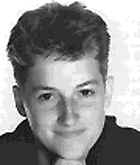 |
Sarah Kane more: decodingsarahkane |
 |
Sarah Kane more: decodingsarahkane |
| Decoding Sarah Kane by Timo Pfaff
Felt it.
1 Introduction: Love and
Violence, Metaphoricity and Literality “Love is war” and “love is a unity”—these are the two main conceptual metaphors underlying Sarah Kane’s play Cleansed (1998). However, and quite paradoxically, Kane realizes these metaphors on stage in a way that could not be more literal. A rather minimalistic language is supported by cruel extremes and an “in-yer-face” directness, hard to digest for the audience. These parameters make up Kane’s theatrical language, which is characterized by a non-realistic approach to its topics and a tendency to let form express meaning. The scenes in Cleansed can, at least partly, be analysed by taking them as figures, as it has been done in one of Kane’s inspirational sources for the play, Roland Barthes’ A Lover’s Discourse. This may sound rather strange, given that Cleansed is a play that literally bursts with atrocities like cut-off tongue, hands, and feet, an impaling scene and lots more. Indeed, what fascinated Kane most was Barthes’ contemplation on Bruno Bettelheim’s comparison of the feelings of a lover to those of an inmate of Dachau: “The amorous catastrophe may be close to what has been called, in the psychotic domain, an extreme situation, ‘a situation experienced by the subject as irremediably bound to destroy him;’ the image is drawn from what occurred at Dachau” (48-49). Barthes questions the acceptability of such an immoral comparison, but concludes that it is justified because both “are, literally, panic situations: situations without remainder, without return: I have projected myself into the other with such power that when I am without the other I cannot recover myself, regain myself: I am lost, forever” (49). This literality is a key feature in Sarah Kane’s plays. The audience witnesses literary metaphors that have come into being on stage, revolving around the issue of love and war/violence: “A parable about love in a time of madness, Cleansed is full of metaphors of addiction, need, loss and suffering” (Sierz 114). Anna Opel explains Kane’s use of minimalism in
language and metaphor on stage as Kane’s quest for
her own language of theatre: “Die Suche nach dieser
Theatersprache beinhaltet in Kanes Ästhetik eine
Buchstäblichkeit der Sprache, die etwa in Cleansed ein
Eigenleben entwickelt und als monströse Materialität
wiederkehrt” (169). Furthermore, Opel states:
“Das Verfahren der Ausgestaltung sprachlicher
Wendungen als Wirklichkeit, also als Figuren und
Handlungen, führt zur Verdeutlichung und Zuspitzung von
Aussagen” Thus, my analysis will take place within the parameters of love and violence/war on the one axis and metaphor and literality on the other axis. The metaphors in Cleansed, however, are not realized on the linguistic level but they appear directly on stage, are a result of what I would like to call ‘figurative scenes,’ in accordance with Roland Barthes’ technique of analysis in A Lover’s Discourse (3-6). This is to say, there is no or little such thing as figurative speech; metaphorical significance comes into being in the larger context of statements put together, making up a scene that “says” more than what is actually said on stage. In the course of my analysis, I would like to place Cleansed in the context of two further works, namely Plato’s Symposium, and here especially the speech of Aristophanes who interprets love in terms of a pursuit of wholeness; and Friedrich Nietzsche’s On Truth and Lie in an Extra-Moral Sense, a treatise on the origin of language and human quest for truth. Nietzsche in particular focuses on the phenomenon of metaphor in language and human perception. I will try to transfer his findings to the stage of Kane’s play. The methodical proceeding of my analysis will largely be based on Kövecses’ reworking of Lakoff’s findings in the field of cognitive linguistics. Kövecses outlines the concept of conceptual metaphors: “In the cognitive linguist view, metaphor is defined as understanding one conceptual domain in terms of another conceptual domain” (4), with a “conceptual domain” being “any coherent organization of experience” (4). Furthermore, as I have already hinted at above, one has to distinguish conceptual metaphors from metaphorical linguistic expressions, which “are linguistic manifestations of conceptual metaphors” (Kövecses 39). What is of special interest with regard to Kane is how her mapping of metaphors works, that is to say, how the source domain and the target domain correspond, or how several conceptual domains are being blended into “a nightmare, self-contained, like something jointly dreamt by Goya and Odilon Redon, a vision of monsters and victims” (Peter, Sunday Times). Chapter 2.1 focuses on the appearance of violence and in the play. Here, I will try to reveal several conceptual metaphors that underlie these atrocities. In chapter 2.2, I will focus on the second part of this binary opposition, namely the occurrences of different forms of love in Cleansed, in most instances based on the conceptual metaphor “love is a unity.” This will be emphasized by outlining an analogy between the play and Aristophanes’ myth of love. Chapter 2.3, then, turns to a further analytical dimension of the play: the interaction between metaphoricity and literality. In the final chapter I intend to elucidate Kane’s modus operandi in terms of theatre by comparing Cleansed with the above mentioned Nietzschean essay.
reproduced on the site with the kind
permission of the author |
click for next chapters
www.iainfisher.com / send mail / © 2000-2012 Iain Fisher